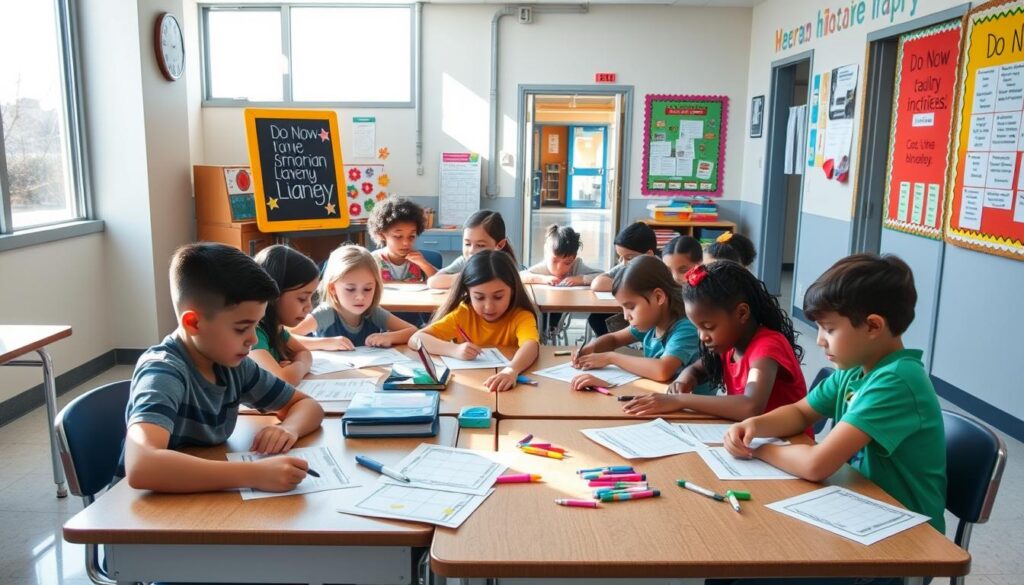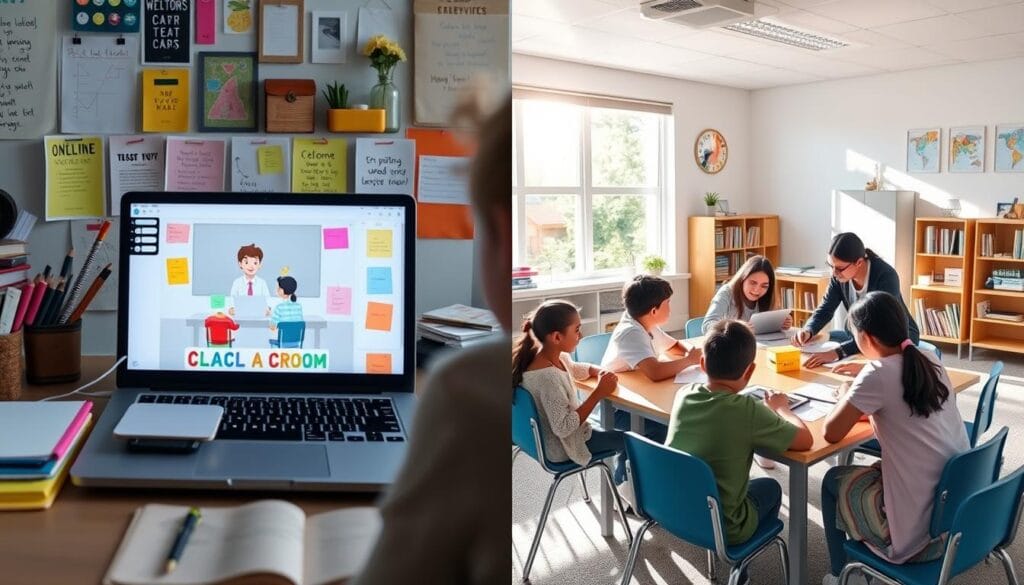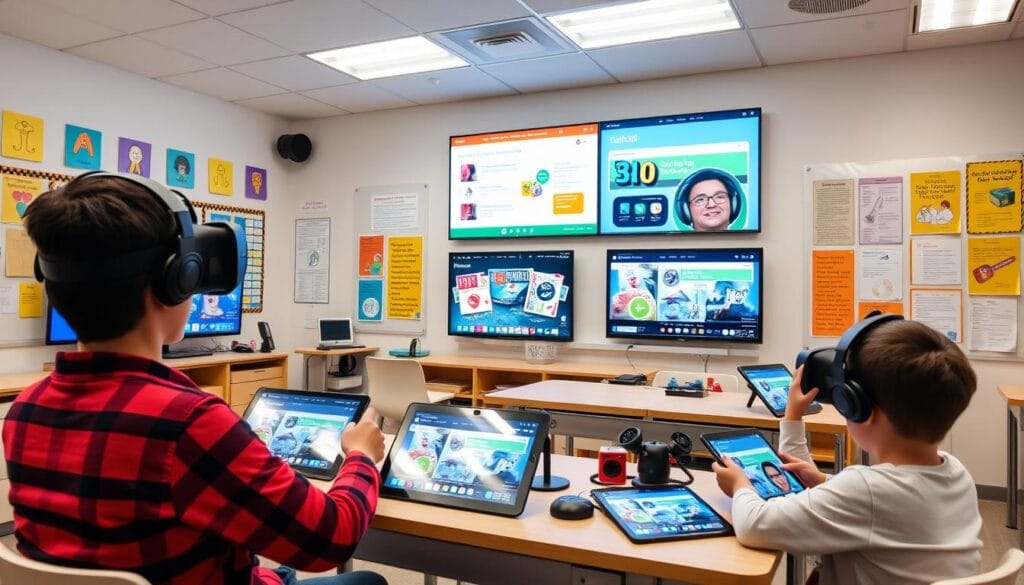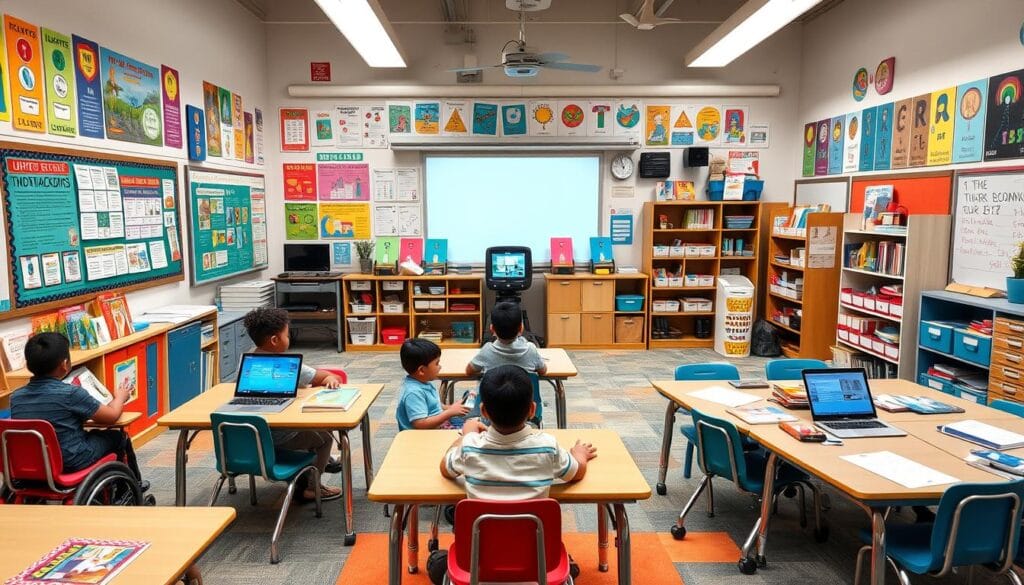Essential Guide to Choosing the Right Teaching Materials
Choosing the right teaching materials is key to a great learning environment. The right resources can boost student engagement and success. As a teacher, finding the best materials can seem hard. But, with the right tips, you can make your classroom the best it can be.
فهرس المقالة
Understanding the Importance of Quality Teaching Materials
Quality teaching materials are key in education. They greatly affect how well students learn, help teachers manage the classroom, and support different learning ways. It’s important to invest in good teaching resources to help students succeed and make learning fun.
Impact on Student Learning Outcomes
Good instructional materials directly help students do well in school. When students use engaging and right-for-their-age materials, they learn better and remember more. These resources improve understanding, thinking skills, and problem-solving abilities.
Role in Effective Classroom Management
Quality classroom materials also help teachers manage the classroom well. Materials that are well-organized and look good keep students focused and reduce distractions. When students use interesting and relevant resources, they stay interested and focused during lessons.
Supporting Different Learning Styles
Students learn in different ways, and they need different materials to do well. Good teaching materials should include things like books, videos, hands-on activities, and interactive games. This way, all students can find something that works for them.
Investing in quality teaching materials is vital for a good learning environment. By understanding how these materials affect learning, classroom management, and different learning styles, teachers can make better choices. This helps improve the learning experience for everyone.
| Aspect | Importance of Quality Teaching Materials |
|---|---|
| Student Learning Outcomes | Enhance comprehension, retention, and proficiency in subject matter |
| Classroom Management | Maintain student attention, minimize disruptive behaviors, and foster a productive learning environment |
| Learning Styles | Cater to visual, auditory, and kinesthetic preferences, ensuring inclusive learning opportunities |
Key Factors in Choosing Teaching Materials

When picking teaching materials, several key factors are important. These factors help ensure the resources match your curriculum, goals, and students’ needs.
First, consider the content relevance of the materials. They should be accurate, current, and relevant to your learning goals. Make sure the material covers the topic well.
Also, think about the age appropriateness of the materials. They should fit your students’ grade level and developmental stage. This helps keep them engaged and learning well.
- Cultural sensitivity: The materials should respect and include diverse cultures, avoiding stereotypes or biases.
- Alignment with educational goals: The resources should match your educational goals, standards, and outcomes.
- Instructional flexibility: Choose materials that offer various teaching methods. This helps meet different learning styles and needs in your classroom.
By considering these factors, you can pick materials that support your curriculum and help your students learn effectively.
| Factor | Description |
|---|---|
| Content Relevance | The teaching materials should be accurate, up-to-date, and directly relevant to the learning objectives and subject matter. |
| Age Appropriateness | The content, language, and visual elements should be tailored to the specific grade level and developmental stage of the students. |
| Cultural Sensitivity | The teaching materials should be inclusive and respectful of diverse cultural backgrounds, avoiding stereotypes or biases. |
| Alignment with Educational Goals | The resources should be closely aligned with the overall educational goals, curriculum standards, and learning outcomes. |
| Instructional Flexibility | The teaching materials should offer a variety of instructional strategies to cater to different learning styles and needs within the classroom. |
“Choosing the right teaching materials is a crucial step in creating an engaging and effective learning environment for your students.”
Aligning Materials with Curriculum Standards
Choosing the right educational resources is key in curriculum planning and lesson planning. It’s important to check if the materials match the curriculum standards at the state and national levels.
State and National Educational Requirements
Make sure the teaching materials you pick meet your state and national standards. This ensures your students get a well-rounded education. It also keeps you in line with local and federal rules.
Grade-Level Appropriateness
The educational resources should fit your students’ grade level. Think about the reading level, concept complexity, and if it’s right for their age.
Learning Objectives Alignment
Your teaching materials should match the learning goals you set for your students. This makes sure you’re teaching the right skills and knowledge. It helps in planning a cohesive and effective curriculum planning approach.
| Curriculum Standard Alignment | Grade-Level Appropriateness | Learning Objectives Alignment |
|---|---|---|
| Ensure materials meet state and national requirements | Match content complexity to student developmental level | Reinforce specific skills and knowledge you want to teach |
| Maintain compliance with educational regulations | Consider reading level, concept difficulty, and age-appropriateness | Promote a cohesive and effective lesson planning approach |
“Aligning your educational resources with curriculum standards and learning objectives is essential for delivering a high-quality, impactful education.”
Digital vs. Traditional Teaching Resources

Technology is changing how we teach and learn. The debate between digital and traditional teaching resources is growing. Both have their own benefits and challenges for teachers.
Digital educational resources like interactive multimedia and online platforms change how students learn. They offer quick feedback and a lot of information. But, they need technology and can be hard to access for everyone.
Traditional teaching aids like textbooks and hands-on materials are familiar and real. They work well for students who like structure. But, they might not be as exciting or in-depth as digital options.
The best way is to mix digital and traditional teaching materials. This creates a rich and varied learning space. It meets the different needs and likes of students.
“The key is to find the right blend of digital and traditional educational resources that maximizes student engagement and learning outcomes.”
Choosing between digital and traditional teaching aids depends on the learning goals and student needs. Teachers should weigh the pros and cons of each. This helps make learning better and more enjoyable for everyone.

Evaluating Cost-Effectiveness and Durability
When picking teaching materials, think about how much they cost and how long they last. Your school’s budget is key in choosing what you can buy. It’s important to find a balance between quality and price.
Budget Considerations
First, look at the cost of the materials. This includes the price, shipping, and any extra things you need. Also, think about how much it will cost to keep them going, like replacing parts. The first price you see is just the start; the ongoing costs can add up fast.
Long-term Value Assessment
Don’t just look at the price. Think about how long the materials will last and if you can use them again. Spending more on quality materials might seem expensive at first. But, they can save you money in the long run because they last longer.
Maintenance Requirements
Check how much upkeep the materials need. Some might need cleaning, updates, or new parts. Knowing this helps you plan and make sure they work well for a long time.
By carefully looking at the cost and durability of teaching materials, you can choose wisely. This way, you can stay within your budget and give your students the best learning experience.
Adapting Materials for Diverse Learning Needs
In the world of instructional design and learning materials, it’s key to meet the needs of all students. Good teaching means making teaching aids and resources fit for many learning styles, abilities, and cultures.
Teaching in a way that meets each student’s needs is vital. By changing learning materials, teachers help all students get the most out of their education.
Strategies for Adapting Materials
- Provide visual aids and multimedia for those who learn best by seeing.
- Use hands-on activities and kinesthetic learning for those who learn by doing.
- Give audio recordings and listening exercises for those who learn by hearing.
- Make language simple, use clear instructions, and offer multilingual support for English learners.
- Adjust content, pace, and goals for students with special needs.
- Use culturally responsive materials that show the diversity of your students.
By carefully adapting instructional design and learning materials, teachers can make a learning space where everyone can succeed.

“Inclusive education is not just about disability. It is about welcoming, celebrating and supporting the diversity that all children bring to the classroom.”
Supplementary Resources and Teaching Aids
In the world of education, extra resources and teaching aids are key. They help make the main curriculum better. These tools grab students’ interest, make learning stick, and fit different learning ways. Let’s look at the various types of extra materials that can make your teaching better and help students understand more.
Visual Learning Tools
Adding visual aids to your lessons can really help students remember and stay interested. Things like posters, infographics, and interactive whiteboards make hard ideas easy to get. Visual learning makes learning fun and helps students connect with what they’re learning.
Interactive Materials
In today’s world, interactive supplementary materials are super important. Things like educational games, virtual labs, and hands-on kits boost thinking and solving problems. These learning materials turn learning into an exciting, memorable journey.
Assessment Resources
Good assessment is key to learning. Tools like quizzes, games, and tests show how students are doing. They help you see where students need help and make your teaching better.
Using a mix of teaching aids, supplementary materials, and learning materials makes learning fun and effective. It meets the needs of all your students. This way, you can help your students achieve great things in school.
Best Practices for Choosing Teaching Materials
Choosing the right teaching materials is key for a successful classroom. Make sure the materials match your curriculum and learning goals. This ensures your students get the right instruction for their grade level and educational needs.
Also, think about the cost and how long the materials will last. Look for options that are affordable and durable. This way, you get the most out of your teaching materials without breaking the bank.
Lastly, tailor your materials to meet the needs of all your students. Use a mix of visual aids and interactive tools. This helps students of different learning styles to understand and engage with the material. By following these tips, you can pick materials that enhance your teaching and help your students succeed.
FAQ
What are the key factors to consider when choosing teaching materials?
When picking teaching materials, think about their relevance and if they fit the age and culture of your students. Also, make sure they match your educational goals and follow the curriculum standards.
How can I ensure the teaching materials I choose support diverse learning needs?
To meet different learning needs, adjust the materials by changing the content or adding visual and interactive elements. Use resources that help various learning styles and abilities.
What are the benefits of using digital teaching resources compared to traditional materials?
Digital resources are interactive, easy to access, and save money. But, they might need special tech and could distract students. Mix digital and traditional materials for the best results.
How can I ensure the teaching materials I choose are aligned with curriculum standards?
Make sure the materials fit state and national education rules. They should be right for the grade level and match the learning goals you have.
What factors should I consider to ensure the long-term cost-effectiveness of teaching materials?
Look at the initial cost and how much value it will last over time. Also, think about how much upkeep it needs. This helps you choose materials that are good for your budget and last long.
What types of supplementary resources and teaching aids can I use to enhance the core curriculum?
Use visual tools, interactive materials, and resources for checking progress. These help keep students interested, teach in different ways, and give feedback on how they’re doing.






